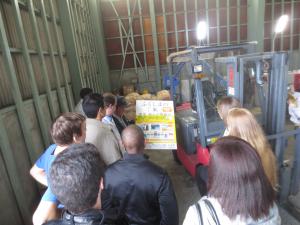On October 19th and 20th, myself and several other ALTs from Fukushima prefecture were fortunate enough to go on a study tour in the Aizu region. This study tour had piqued my interest on two fronts: firstly, we were going to be staying the night at a homestay on a local farm, which I thought would be a fantastic look at the home life of a typical Fukushima resident, and second, we would get a chance to see the efforts being taken to ensure the safety of all of the food produced in the prefecture. There were other stops as well, but those two were my initial draw. To my surprise and enjoyment, the other activities proved to be fascinating too, and I had a fantastic time. Here is my retelling of the adventure. My day started with a bike ride to Fukushima station where our small group was gathering. I had already met most of the people who were leaving from Fukushima city at other events, and it was great to catch up with everyone. Once we had all gathered, we boarded the bus. It was interesting to have only 9 people on a large tour bus that could seat 50, but our numbers swelled considerably once we got to Koriyama and met up with all of the other ALTs. After a quick reunion with the Koriyama ALTs, our bus set off on a short trip to Motomiya and the Fukushima Agricultural Technology Center. The Fukushima Agricultural Technology Center is a massive complex that was built shortly before the March 11th triple disaster to research farming and crops in Fukushima and elsewhere in Japan in order to improve the quality of Japanese agricultural products. It is fitting, then, that this center was chosen as the site of all food inspections to address concerns about radioactive contamination of crops. The center itself is a modern building with an airy, natural feel coming from its environmentally friendly wooden architecture. It really was a gorgeous place and reminded me of a moderns university campus. We were presented with many facts about the food safety procedures in the prefecture. I was very impressed with the diligence of the testing, and the safety procedures in place. If anything came up above the very restrictive radiation limits, all products from that area of the prefecture were marked for testing. We also toured the laboratory, which was state-of-the art and reminded me of my university chemistry days. After a delicious bento lunch, we got back on the bus and headed for the Aizu region. Along the way I caught my first glimpse of mountain snow in the Iide mountain range far to the west, a stark reminder of the approaching winter. We arrived in Kitakata city and proceeded to tour the rice testing facility. I was amazed to learn that every single bag of rice produced in Fukushima prefecture is tested at this facility, and it was very impressive to see the giant storehouses full of recently tested rice. We even got to scan a couple of bags ourselves. The afternoon was dedicated to a tour of Kitakata Kura-no-machi, the Kitakata storehouse village. These are storehouses for sake and other goods that date back to the Meiji era. It was a very impressive place, with much history and fabulous architecture, including some brick storehouses that could have come out of an English town. We then met up with our farmstay hosts. The farmer we stayed with was very personable, and we had a fantastic time at his house. It was a large family estate, with a guesthouse for us to sleep in and a very modern residence for the farmer and his wife, as well as his adult children who lived next door. We were treated to a delicious traditional dinner, and I got to practice my limited Japanese by talking all evening long. At a certain point we were also introduced to his grandchildren. We then settled on our comfortable futons for a well deserved sleep. It began to rain the next morning, but that did not hamper our enjoyment of delicious Kitakata ramen, a tour of the gorgeous Tsurugajo castle, and a fascinating tour of a modern sake brewery. I was very glad to have signed up for the trip and it really opened my eyes to the unique cultural heritage of Fukushima prefecture, and the efforts being taken to ensure the safety of its residents. I can't wait for the next study tour! |  |
| Summary |







